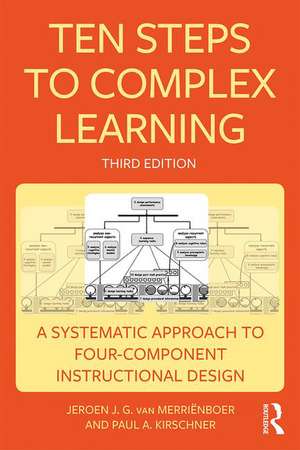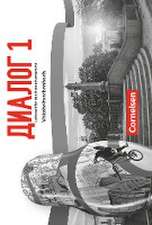Ten Steps to Complex Learning: A Systematic Approach to Four-Component Instructional Design
Autor Jeroen J. G. van Merriënboer, Paul A. Kirschneren Limba Engleză Paperback – 24 oct 2017
Now fully revised to incorporate the most current research in the field, this third edition of Ten Steps to Complex Learning includes many references to recent research as well as two new chapters. One new chapter deals with the training of 21st-century skills in educational programs based on the Ten Steps. The other deals with the design of assessment programs that are fully aligned with the Ten Steps. In the closing chapter, new directions for the further development of the Ten Steps are discussed.
| Toate formatele și edițiile | Preț | Express |
|---|---|---|
| Paperback (1) | 232.10 lei 22-36 zile | +22.14 lei 5-11 zile |
| Taylor & Francis – 24 oct 2017 | 232.10 lei 22-36 zile | +22.14 lei 5-11 zile |
| Hardback (1) | 953.72 lei 22-36 zile | |
| Taylor & Francis – 19 oct 2017 | 953.72 lei 22-36 zile |
Preț: 232.10 lei
Nou
Puncte Express: 348
Preț estimativ în valută:
44.42€ • 46.11$ • 37.04£
44.42€ • 46.11$ • 37.04£
Carte disponibilă
Livrare economică 03-17 martie
Livrare express 14-20 februarie pentru 32.13 lei
Preluare comenzi: 021 569.72.76
Specificații
ISBN-13: 9781138080805
ISBN-10: 1138080802
Pagini: 416
Ilustrații: 38 Tables, black and white; 61 Line drawings, black and white; 25 Halftones, black and white; 86 Illustrations, black and white
Dimensiuni: 152 x 229 x 30 mm
Greutate: 0.58 kg
Ediția:3 ed
Editura: Taylor & Francis
Colecția Routledge
Locul publicării:Oxford, United Kingdom
ISBN-10: 1138080802
Pagini: 416
Ilustrații: 38 Tables, black and white; 61 Line drawings, black and white; 25 Halftones, black and white; 86 Illustrations, black and white
Dimensiuni: 152 x 229 x 30 mm
Greutate: 0.58 kg
Ediția:3 ed
Editura: Taylor & Francis
Colecția Routledge
Locul publicării:Oxford, United Kingdom
Public țintă
Academic, Postgraduate, Professional, and Professional Practice & DevelopmentCuprins
CONTENTS
About the Authors
Preface
Acknowledgements
1 A NEW APPROACH TO INSTRUCTION
1.1 Complex Learning
1.2 A Holistic Design Approach
1.3 Four Components and Ten Steps
2 FOUR BLUEPRINT COMPONENTS
2.1 Training Blueprints
2.2 Preventing Compartmentalization
2.3 Avoiding Fragmentation
2.4 Dealing with the Transfer Paradox
2.5 Individualized Instruction
2.6 Media for the Four Components
2.7 Summary
3 TEN STEPS
3.1 Ten Design Activities
3.2 System Dynamics
3.3 The Pebble-in-the-Pond: From Activities to Steps
3.4 Ten Steps within an ISD Context
3.5 Summary
4 STEP 1: DESIGN LEARNING TASKS
4.1 Real-Life Tasks
4.2 Real and Simulated Task Environments
4.3 Variability of Practice
4.4 Learner Support and Guidance
4.5 Built-in Task Support
4.6 Problem-Solving Guidance
4.7 Scaffolding Support and Guidance
4.8 Summary of Guidelines
5 STEP 2: DESIGN PERFORMANCE ASSESSMENTS
5.1 Skill Decomposition
5.2 Formulating Performance Objectives
5.3 Classifying Performance Objectives
5.4 Performance Assessments
5.5 Summary of Guidelines
6 STEP 3: SEQUENCE LEARNING TASKS
6.1 Whole-Task Sequencing of Learning Tasks
6.2 Task Classes and Learner Support
6.3 Part-Task Sequencing of Learning Tasks
6.4 Individualized Learning Trajectories
6.5 Summary of Guidelines
7 STEP 4: DESIGN SUPPORTIVE INFORMATION
7.1 Providing SAPs and Domain Models
7.2 Illustrating SAPs and Domain Models
7.3 Strategies for Presenting Supportive Information
7.4 Cognitive Feedback
7.5 Media for Supportive Information
7.6 Supportive Information in the Training Blueprint
7.7 Summary of Guidelines
8 STEP 5: ANALYZE COGNITIVE STRATEGIES
8.1 Specify SAPs
8.2 Analyzing Intuitive Cognitive Strategies
8.3 Using SAPs to Make Design Decisions
8.4 Summary of Guidelines
9 STEP 6: ANALYZE MENTAL MODELS
9.1 Specify Domain Models
9.2 Analyzing Intuitive Mental Models
9.3 Using Domain Models to Make Design Decisions
9.4 Summary of Guidelines
10 STEP 7: DESIGN PROCEDURAL INFORMATION
10.1 Providing Just-In-Time Information Displays
10.2 Exemplifying Just-In-Time Information
10.3 Strategies for Presenting Procedural Information
10.4 Corrective Feedback
10.5 Media for Procedural Information
10.6 Procedural Information in the Training Blueprint
10.7 Summary of Guidelines
11 STEP 8: ANALYZE COGNITIVE RULES
11.1 Specify IF-THEN Rules and Procedures
11.2 Analyzing Typical Errors and Malrules
11.3 Using Cognitive Rules to Make Design Decisions
11.4 Summary of Guidelines
12 STEP 9: ANALYZE PREREQUISITE KNOWLEDGE
12.1 Specify Concepts, Facts, and Physical Models
12.2 Analyzing Misconceptions
12.3 Using Prerequisite Knowledge to Make Design Decisions
12.4 Summary of Guidelines
13 STEP 10: DESIGN PART-TASK PRACTICE
13.1 Practice Items
13.2 Part-Task Sequencing for Part-Task Practice
13.3 Procedural Information for Part-Task Practice
13.4 Overlearning
13.5 Independent Part-Task Practice
13.6 Media for Part-Task Practice
13.7 Part-Task Practice in the Training Blueprint
13.8 Summary of Guidelines
14 DOMAIN-GENERAL SKILLS
14.1 Self-Regulated and Self-Directed Learning
14.2 Training Information Literacy Skills
14.3 Deliberate Practice for Building Routines
14.4 21st Century Skills
14.5 Summary
15 PROGRAMS OF ASSESSMENT
15.1 Miller’s Pyramid and the Four Components
15.2 Summative Assessment of Learning Tasks
15.3 Summative Assessment of Supportive Information
15.4 Summative Assessment of Part-Tasks and Procedural Information
15.5 Summative Assessment of Domain-General Skills
15.6 Summary
16 CLOSING REMARKS
16.1 Positioning the Ten Steps
16.2 Future Directions
16.3 A Final Word
About the Authors
Preface
Acknowledgements
1 A NEW APPROACH TO INSTRUCTION
1.1 Complex Learning
1.2 A Holistic Design Approach
1.3 Four Components and Ten Steps
2 FOUR BLUEPRINT COMPONENTS
2.1 Training Blueprints
2.2 Preventing Compartmentalization
2.3 Avoiding Fragmentation
2.4 Dealing with the Transfer Paradox
2.5 Individualized Instruction
2.6 Media for the Four Components
2.7 Summary
3 TEN STEPS
3.1 Ten Design Activities
3.2 System Dynamics
3.3 The Pebble-in-the-Pond: From Activities to Steps
3.4 Ten Steps within an ISD Context
3.5 Summary
4 STEP 1: DESIGN LEARNING TASKS
4.1 Real-Life Tasks
4.2 Real and Simulated Task Environments
4.3 Variability of Practice
4.4 Learner Support and Guidance
4.5 Built-in Task Support
4.6 Problem-Solving Guidance
4.7 Scaffolding Support and Guidance
4.8 Summary of Guidelines
5 STEP 2: DESIGN PERFORMANCE ASSESSMENTS
5.1 Skill Decomposition
5.2 Formulating Performance Objectives
5.3 Classifying Performance Objectives
5.4 Performance Assessments
5.5 Summary of Guidelines
6 STEP 3: SEQUENCE LEARNING TASKS
6.1 Whole-Task Sequencing of Learning Tasks
6.2 Task Classes and Learner Support
6.3 Part-Task Sequencing of Learning Tasks
6.4 Individualized Learning Trajectories
6.5 Summary of Guidelines
7 STEP 4: DESIGN SUPPORTIVE INFORMATION
7.1 Providing SAPs and Domain Models
7.2 Illustrating SAPs and Domain Models
7.3 Strategies for Presenting Supportive Information
7.4 Cognitive Feedback
7.5 Media for Supportive Information
7.6 Supportive Information in the Training Blueprint
7.7 Summary of Guidelines
8 STEP 5: ANALYZE COGNITIVE STRATEGIES
8.1 Specify SAPs
8.2 Analyzing Intuitive Cognitive Strategies
8.3 Using SAPs to Make Design Decisions
8.4 Summary of Guidelines
9 STEP 6: ANALYZE MENTAL MODELS
9.1 Specify Domain Models
9.2 Analyzing Intuitive Mental Models
9.3 Using Domain Models to Make Design Decisions
9.4 Summary of Guidelines
10 STEP 7: DESIGN PROCEDURAL INFORMATION
10.1 Providing Just-In-Time Information Displays
10.2 Exemplifying Just-In-Time Information
10.3 Strategies for Presenting Procedural Information
10.4 Corrective Feedback
10.5 Media for Procedural Information
10.6 Procedural Information in the Training Blueprint
10.7 Summary of Guidelines
11 STEP 8: ANALYZE COGNITIVE RULES
11.1 Specify IF-THEN Rules and Procedures
11.2 Analyzing Typical Errors and Malrules
11.3 Using Cognitive Rules to Make Design Decisions
11.4 Summary of Guidelines
12 STEP 9: ANALYZE PREREQUISITE KNOWLEDGE
12.1 Specify Concepts, Facts, and Physical Models
12.2 Analyzing Misconceptions
12.3 Using Prerequisite Knowledge to Make Design Decisions
12.4 Summary of Guidelines
13 STEP 10: DESIGN PART-TASK PRACTICE
13.1 Practice Items
13.2 Part-Task Sequencing for Part-Task Practice
13.3 Procedural Information for Part-Task Practice
13.4 Overlearning
13.5 Independent Part-Task Practice
13.6 Media for Part-Task Practice
13.7 Part-Task Practice in the Training Blueprint
13.8 Summary of Guidelines
14 DOMAIN-GENERAL SKILLS
14.1 Self-Regulated and Self-Directed Learning
14.2 Training Information Literacy Skills
14.3 Deliberate Practice for Building Routines
14.4 21st Century Skills
14.5 Summary
15 PROGRAMS OF ASSESSMENT
15.1 Miller’s Pyramid and the Four Components
15.2 Summative Assessment of Learning Tasks
15.3 Summative Assessment of Supportive Information
15.4 Summative Assessment of Part-Tasks and Procedural Information
15.5 Summative Assessment of Domain-General Skills
15.6 Summary
16 CLOSING REMARKS
16.1 Positioning the Ten Steps
16.2 Future Directions
16.3 A Final Word
Notă biografică
Jeroen J. G. van Merriënboer is Professor of Learning and Instruction at Maastricht University, the Netherlands, where he is Research Director of the Graduate School of Health Professions Education (SHE). He also holds honorary positions at the University of Bergen in Norway and the Open University of the Netherlands. He has published over 300 journal articles and book chapters in the areas of learning and instruction and medical education.Paul A. Kirschner is Distinguished University Professor and Professor of Educational Psychology at the Open University of the Netherlands, as well as Visiting Professor of Education with a special emphasis on Learning and Interaction in Teacher Education at the University of Oulu, Finland. He has published more than 300 journal articles, books, and book chapters in the areas of learning, instruction, and collaborative learning.
Recenzii
"There are many books on instructional design and many books on learning theory and human cognition. There are very few that adequately discuss both human cognitive processes and the instructional design principles that flow from our knowledge of cognition. This book manages the regretfully rare feat of intelligently describing both processes. It should be read by everyone interested in instructional procedures. If we can convince educators to follow the ten steps, both they and their students will have their working lives enhanced."
—John Sweller, Emeritus Professor of Educational Psychology in the School of Education at the University of New South Wales, Australia
Descriere
Ten Steps to Complex Learning presents a path from a training problem to a training solution in a way that students, practitioners (both instructional designers and teachers), and researchers can understand and easily implement.














